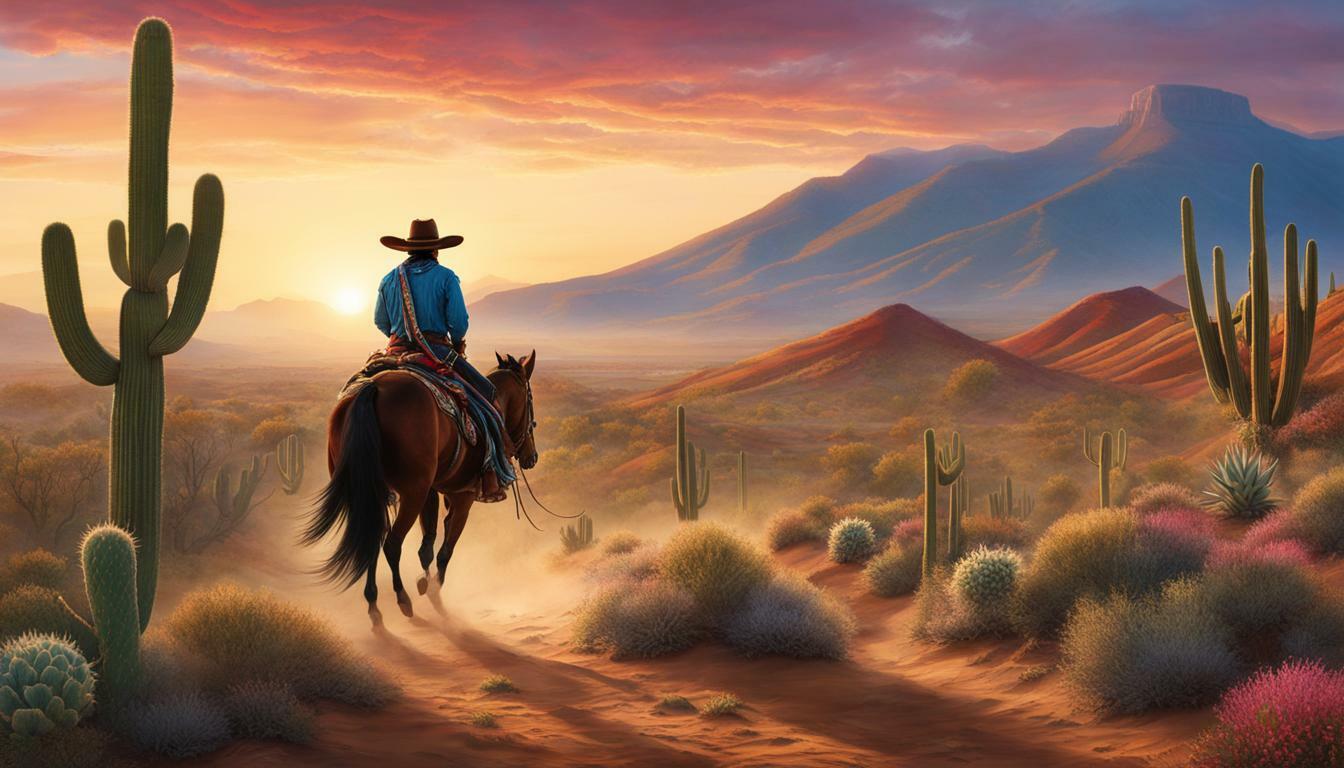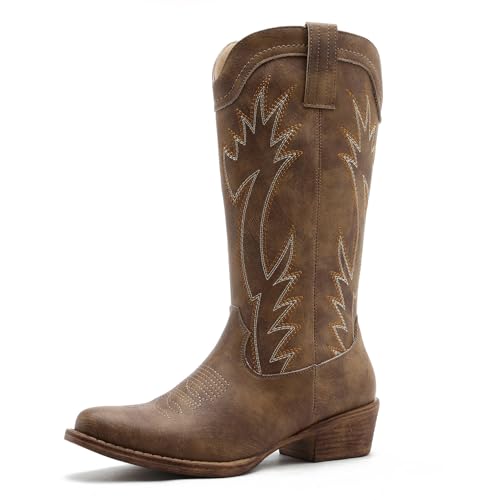Step into the engaging world of the Mexican cowboy and discover the rich heritage of the vaquero culture. The vaquero, also known as the Mexican cowboy, is a horse-mounted livestock herder that originated in the Iberian Peninsula and developed extensively in Mexico. They served as the foundation for the North American cowboy, with their skills in taming wild horses and using lassos for herding cattle.
The vaqueros were mainly Indigenous Mexican men who learned horsemanship from Spanish colonizers. They played a crucial role in the ranching industry, herding cattle and training newcomers in cowboy skills. Even today, the vaquero culture remains present in modern-day rodeo and ranching, with many vaquero techniques still practiced on ranches across Mexico and beyond.
Join us as we delve into the captivating world of the Mexican cowboy, exploring their vibrant culture, traditional attire, and thrilling rodeo skills that define this iconic persona. Discover the enduring charisma of the vaquero and the role they continue to play as guardians of tradition. Stay tuned for an exciting journey filled with rich history and timeless traditions.
The Origins of the Mexican Cowboy
The vaquero, or Mexican cowboy, had its beginnings in the Iberian Peninsula and later became a key figure in the ranching industry in Mexico. These skilled horsemen played a crucial role in herding cattle and training newcomers in cowboy skills. The vaquero culture and techniques have left a lasting impact on modern-day rodeo and ranching practices.
The vaqueros were primarily Indigenous Mexican men who were taught horsemanship by the Spanish colonizers. They honed their riding skills and mastered the use of lassos to efficiently herd cattle. The vaqueros’ expertise in handling livestock and taming wild horses laid the foundation for the North American cowboy, whose image has since become synonymous with the Wild West.
The vaquero’s legacy in the ranching industry cannot be overstated. Their horsemanship and roping abilities were essential in managing herds of cattle, ensuring the success and growth of the ranching industry. Today, many vaquero techniques are still used on ranches across Mexico and beyond, a testament to their enduring significance.
| Vaquero Contributions |
|---|
| Skilled horsemen |
| Efficient cattle herding |
| Training newcomers in cowboy skills |
| Influence on modern-day rodeo and ranching |
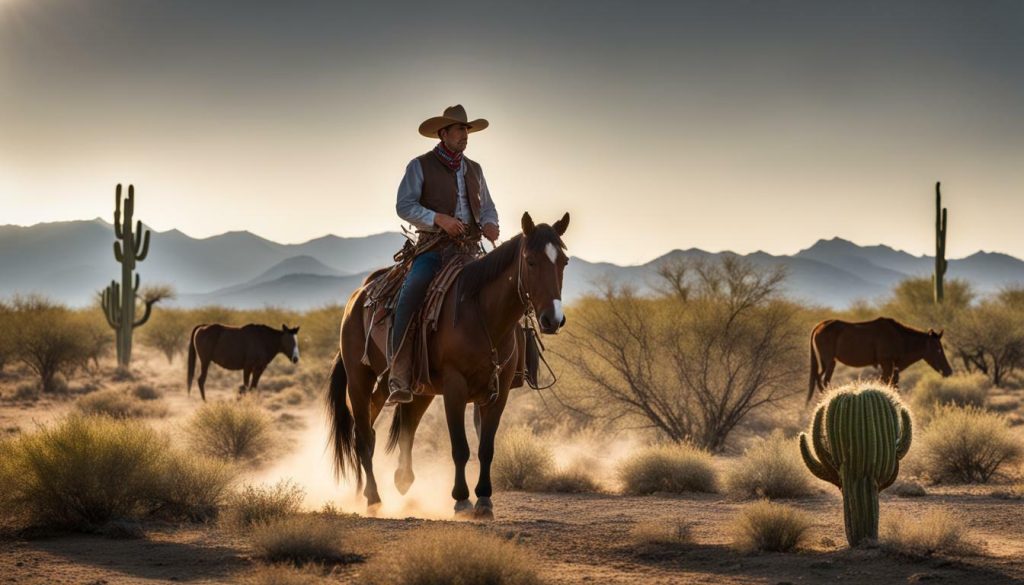
“The vaquero’s expertise in handling livestock and taming wild horses laid the foundation for the North American cowboy.”
Traditional Mexican Wear and Charro Outfits
The Mexican cowboy’s traditional wear, including elaborate charro outfits and distinctive cowboy boots, reflects their rich cultural heritage. These iconic charro outfits are known for their vibrant colors, intricate embroidery, and ornate silver embellishments. A typical charro outfit consists of a wide-brimmed sombrero, a fitted jacket known as a chaquetilla, a pair of tailored trousers called calzoneras, and a wide waist belt known as a sash or faja.
One of the most striking elements of the charro outfit is the traditional Mexican cowboy boots. These boots, known as botas vaqueras, are handmade with fine leather and often feature intricate stitching and decorative designs. With their pointed toes and high heels, these boots not only serve a practical purpose in the saddle but also symbolize the vaquero’s distinctive style.
The charro outfits and Mexican cowboy boots are deeply rooted in the vaquero culture and are worn with pride during rodeo events and traditional celebrations. They represent the vaquero’s connection to their Mexican heritage and their dedication to preserving their traditions.
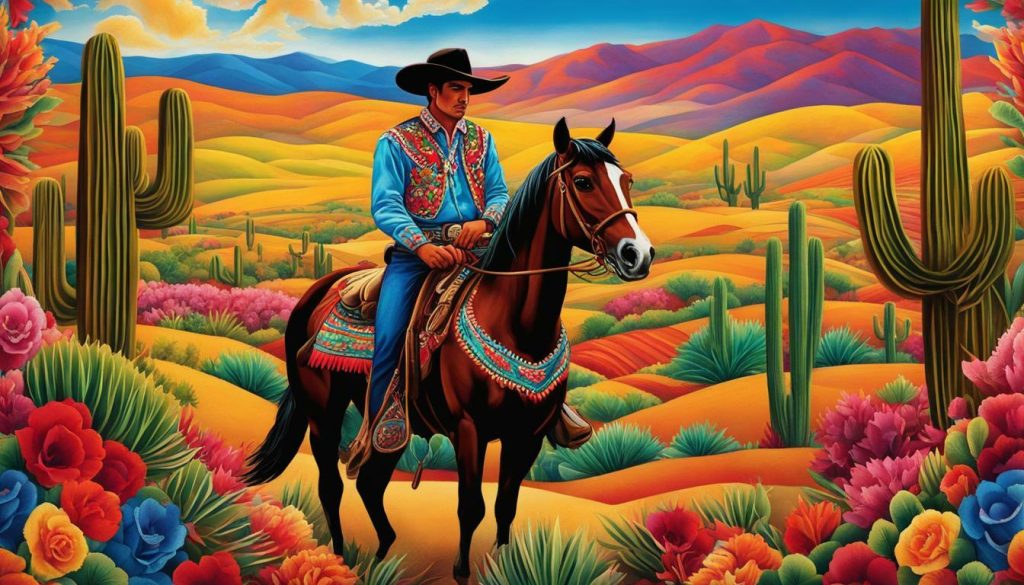
It is essential to acknowledge the cultural significance of the charro outfits and Mexican cowboy boots. They represent more than just clothing; they embody the spirit, craftsmanship, and legacy of the Mexican cowboy.
In addition to their ornate attire, the vaqueros also take great pride in their impressive horsemanship skills. From roping and riding to cattle herding, the vaqueros showcase their expertise in various rodeo events. These events not only entertain spectators but also serve as a testament to the enduring legacy of the vaquero culture.
The Influence of Mexican Cowboy Fashion
The influence of the Mexican cowboy on Western cowboy fashion is undeniable. Elements of Mexican cowboy attire, such as the charro outfits and Mexican cowboy boots, have made their way into Western fashion, creating a unique blend of cultural exchange. Today, Western cowboys can be seen donning charro-inspired jackets, embroidered shirts, and, of course, the iconic Mexican cowboy boots.
The vaquero culture continues to thrive in modern-day rodeo and ranching, with vaquero techniques still being practiced and passed down through generations. Mexican cowboys, or vaqueros, are not just skilled horsemen; they are the guardians of a rich tradition that encompasses history, culture, and a deep connection to the land.
| Vaquero Techniques | Description |
|---|---|
| Roping | The vaqueros are known for their exceptional roping skills, using lassos to capture and control livestock. |
| Cattle Herding | From large herds to individual animals, the vaqueros expertly guide and manage cattle across vast ranches. |
| Horsemanship | The vaqueros’ ability to handle and train horses is unmatched, having honed their skills over centuries of working closely with these majestic animals. |
The future of the Mexican cowboy, with their vaquero culture and traditions, lies in the hands of those who continue to honor and teach these timeless skills. Through their commitment to the art of horsemanship, their vibrant attire, and their unwavering dedication, the Mexican cowboy continues to captivate audiences while preserving a heritage that stretches back to the origins of ranching.
Vaquero Culture and Mariachi Cowboys
The vaquero culture extends beyond the ranching industry, influencing the music and art of Mexico, as seen in the vibrant world of the mariachi cowboys. The mariachi cowboys are a captivating fusion of traditional Mexican music and the skills and attire of the vaquero. Dressed in ornate charro outfits, they showcase the rich heritage of the Mexican cowboy through their vibrant performances.
The mariachi cowboys are known for their energetic music, combining the sounds of trumpets, violins, and guitars with powerful vocals. Their performances are filled with passion and emotion, captivating audiences with their lively melodies and traditional songs. The mariachi cowboys bring the vaquero culture to life through their music, preserving the essence of this iconic persona.
Just as the vaquero culture has influenced music, it has also left its mark on Mexican art. From vibrant paintings depicting the adventures of the Mexican cowboy to intricate sculptures capturing their lively spirit, vaquero culture is celebrated in various art forms. These artistic expressions pay homage to the vaquero’s bravery, horsemanship, and deep connection to the land.

The Enduring Legacy
The vaquero culture continues to captivate audiences worldwide, enchanting them with the timeless charm of the Mexican cowboy. From the thrilling rodeo skills to the traditional attire and music, the vaquero culture serves as a reminder of the rich heritage and traditions that have shaped Mexico.
As we look to the future, it’s important to preserve and honor this legacy. Efforts are being made to ensure that the vaquero culture is passed down to future generations, keeping the spirit of the Mexican cowboy alive. By celebrating their traditions and embracing their cultural significance, we can ensure that the vaquero’s enduring charisma remains a cherished part of Mexican culture.
| Vaquero Culture | Mariachi Cowboys |
|---|---|
| – Origins in Iberian Peninsula and developed in Mexico | – Fusion of traditional Mexican music with vaquero skills and attire |
| – Played crucial role in ranching industry | – Energetic performances filled with passion and emotion |
| – Influence on Mexican art | – Vibrant charro outfits and traditional songs |
| – Enduring legacy | – Preserving the vaquero culture for future generations |
The Thrilling Rodeo Skills of the Mexican Cowboy
Discover the exhilarating rodeo skills of the Mexican cowboy, showcasing their unmatched horsemanship and roping abilities across a range of thrilling events. The vaquero, also known as the Mexican cowboy, has a rich tradition of honing their skills in the rodeo arena.
One of the most exciting events in which the Mexican cowboy displays their prowess is the roping competition. With lightning-fast reflexes and precision, they rope cattle with remarkable accuracy, earning points for speed and technique. Watching a vaquero effortlessly swing a lasso and catch a running steer is a true spectacle of skill and agility.
Another thrilling event that highlights the horsemanship of the Mexican cowboy is the bull riding competition. These fearless riders showcase their ability to stay on the back of a bucking bull for eight seconds while maintaining control and balance. The vaquero’s deep connection with their horse allows them to navigate the powerful movements of the bull, showcasing their exceptional riding skills.
| Rodeo Event | Description |
|---|---|
| Steer Wrestling | Also known as “bulldogging,” this event requires the cowboy to catch a running steer and bring it to the ground using strength and technique. |
| Team Roping | A thrilling event where two cowboys work together to rope a steer. One ropes the head, while the other ropes the hind legs, demonstrating exceptional teamwork and coordination. |
| Bareback Riding | In this event, the cowboy must stay on the back of a bucking horse with only a rigging as a handhold, showcasing their balance and control. |
The vaquero’s exceptional rodeo skills have not only influenced the Mexican cowboy culture but have also left a lasting impact on the broader cowboy world. Many vaquero techniques, such as roping and horse training methods, are still widely used in modern-day rodeos and on ranches.
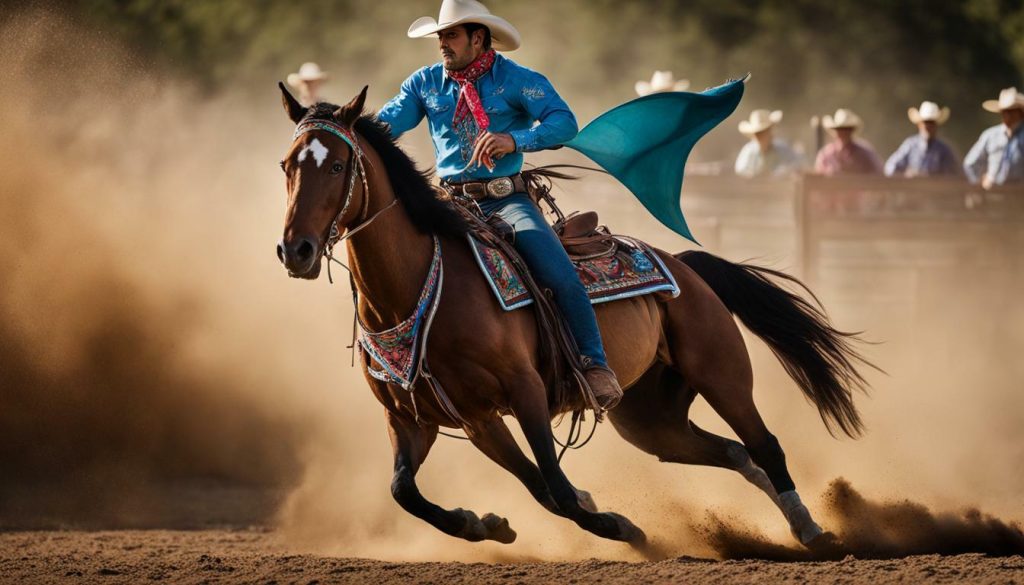
The rodeo attire of the Mexican cowboy, with its distinctive charro outfits and well-worn Mexican cowboy boots, adds to the allure of their exhilarating performances. The vibrant colors and intricate details of their attire reflect the rich cultural heritage of the vaquero.
In the words of a Mexican cowboy:
“The rodeo is where I feel most alive. It’s the perfect blend of tradition, skill, and adrenaline. Every time I swing that lasso or ride a bucking bull, I’m reminded of the legacy of the vaquero and its enduring impact on the cowboy way of life.”
As the vaquero culture continues to thrive in rodeo events and on ranches, the thrilling rodeo skills of the Mexican cowboy will undoubtedly captivate audiences for generations to come. Their unmatched horsemanship and roping abilities make them true legends of the rodeo arena.
Mexican Cowboys in Western Cowboy Fashion
The Mexican cowboy has left an indelible mark on Western cowboy fashion, with their distinctive style and traditional elements influencing the broader cowboy culture. The fusion of Mexican and Western cowboy fashion has created a unique blend that celebrates the rich heritage of the vaquero and captivates fashion enthusiasts worldwide.
The traditional attire of the Mexican cowboy, also known as the charro outfit, includes intricately embroidered jackets, wide-brimmed sombreros, and, of course, the iconic Mexican cowboy boots. These boots, adorned with decorative stitching and often made from fine leather, have become synonymous with Western cowboy fashion, adding a touch of Mexican flair to cowboy attire.
With their vibrant colors and ornate designs, Mexican cowboy attire has made its way into mainstream fashion, inspiring designers and influencing popular Western cowboy clothing lines. The incorporation of traditional Mexican elements, such as the use of serapes or ponchos, embroidery, and silver embellishments, has brought a fresh and distinctive interpretation to Western cowboy fashion.
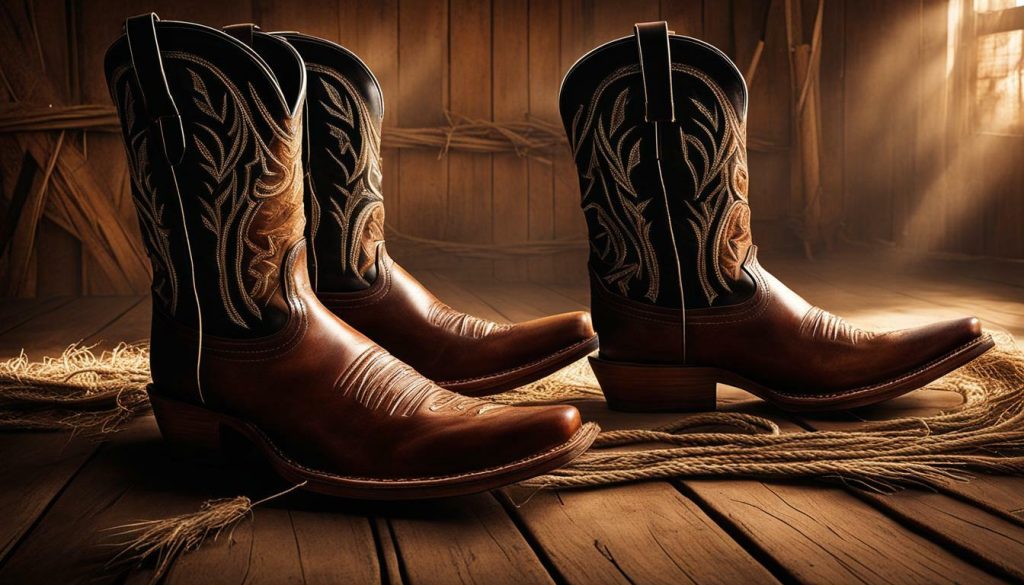
The enduring popularity of Mexican cowboy fashion can be seen in the range of Western cowboy clothing and accessories available today. From cowboy hats with Mexican-inspired patterns to shirts featuring intricate embroidery, the influence of the Mexican cowboy is evident in every aspect of Western cowboy fashion.
| Elements of Mexican Cowboy Fashion | Characteristics |
|---|---|
| Sombreros | Wide-brimmed hats that provide shade and protection from the sun. |
| Charro Jackets | Elaborately embroidered jackets with unique patterns and designs. |
| Mexican Cowboy Boots | Stylish and intricately decorated boots made from fine leather. |
| Serapes and Ponchos | Colorful and patterned shawls worn over the shoulders. |
| Embellishments | Silver adornments, such as buckles and conchos, accentuating the cowboy attire. |
As we celebrate the legacy of the vaquero and Mexican cowboy culture, let us continue to embrace their influence on Western cowboy fashion. The distinctive style and traditional elements of the Mexican cowboy bring a vibrant and captivating dimension to the broader cowboy culture, creating a fashion legacy that will endure for generations to come.
The Vaquero Legacy in Modern-Day Rodeo
The vaquero culture continues to thrive in modern-day rodeo, where traditional attire and skills are celebrated in thrilling events. The enduring influence of the vaquero can be seen in the rodeo attire, which pays homage to the vibrant charro outfits worn by Mexican cowboys. These ornate costumes, adorned with intricate embroidery and silver embellishments, add a touch of cultural flair to the rodeo arena.
One of the most captivating aspects of the vaquero legacy is the display of horsemanship and roping skills. Rodeo events such as bronc riding and team roping showcase the vaquero techniques that have been passed down through generations. The riders demonstrate their mastery of lassoing and controlling wild horses, reminiscent of the vaqueros’ historic role in taming and herding cattle.
To fully appreciate the vaquero culture, one must witness the exhilarating spectacle of the charreada, a Mexican rodeo that brings together traditional horsemanship and festivity. This traditional event features daring feats of skill, including rope tricks, bull riding, and precision horseback riding. The charreada serves as a testament to the continuing influence of the vaquero on modern rodeo.
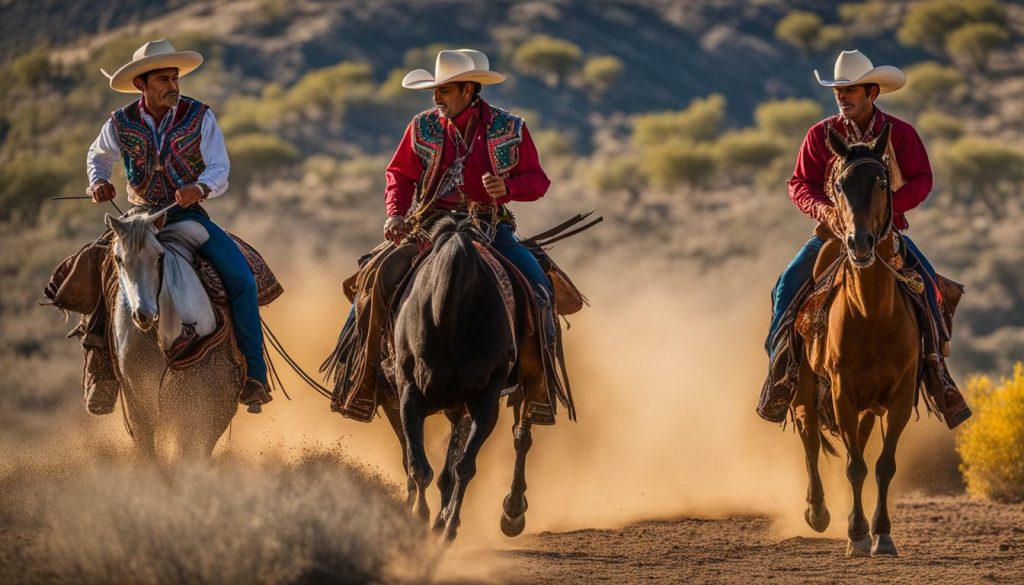
In addition to the thrilling events, the vaquero legacy is also preserved through the dedication of ranching families and Mexican cowboys. These guardians of tradition pass down their knowledge and skills, ensuring that the vaquero culture remains alive and vibrant. Through their commitment, the vaquero continues to inspire future generations of cowboys and cowgirls, keeping the spirit of the Mexican cowboy alive.
| Vaquero Skills | Rodeo Events |
|---|---|
| Horseback Riding | Barrel Racing |
| Lassoing | Team Roping |
| Cattle Herding | Bull Riding |
“Being a vaquero is not just about riding horses and roping cattle. It’s about preserving a cultural heritage and honoring the generations that came before us. The vaquero culture is ingrained in our blood, and we take great pride in carrying on this tradition.” – Javier Hernandez, Mexican Cowboy
Preserving the Vaquero Culture
Efforts are being made to ensure the future of the vaquero culture. Organizations such as the National Vaquero Heritage Center work tirelessly to promote and preserve the traditions of the Mexican cowboy. They offer educational programs and events that celebrate the rich history of the vaquero, ensuring that their legacy continues to flourish for years to come.
As the vaquero culture evolves alongside modern challenges, it remains a symbol of strength, resilience, and cultural identity. From the traditional attire to the exhilarating rodeo skills, the Mexican cowboy continues to captivate audiences worldwide. The vaquero legacy lives on, reminding us of the enduring spirit and heritage of the Mexican cowboy.
Mexican Cowboys as Guardians of Tradition
Mexican cowboys, as guardians of tradition, play a vital role in preserving the vaquero culture and passing it down to new generations of ranchers. Rooted in a rich history that traces back to the vaquero tradition in the Iberian Peninsula, the vaquero culture has become an integral part of Mexican society and the ranching industry.
These skilled horsemen, often Indigenous Mexican men, were taught horsemanship by the Spanish colonizers and became indispensable figures in the ranching industry. They excelled in cattle herding and roping, using their expert techniques to train newcomers in the art of cowboying. Through their dedication and commitment, they ensured the survival of the vaquero culture, passing down their knowledge and skills to future generations.
Today, the vaquero culture remains alive in modern-day rodeo events and ranching practices. Many traditional vaquero techniques, such as horsemanship and cattle herding, are still utilized on ranches across Mexico. The vaquero legacy continues to inspire and influence the cowboy traditions in the United States and beyond, as elements of Mexican cowboy attire and style have been incorporated into Western cowboy fashion.
| Key Elements of Vaquero Culture | Impact on Ranching Industry |
|---|---|
| Traditional horsemanship | Ensuring efficient cattle herding |
| Expert roping skills | Facilitating animal restraint and branding |
| Distinctive charro outfits | Promoting cultural identity and pride |
As the vaquero culture continues to thrive, Mexican cowboys actively promote and celebrate their heritage. Through festivals, gatherings, and cultural events, they keep the vaquero spirit alive, fostering a sense of community among ranchers and preserving the essence of their cowboy traditions. Their unwavering dedication ensures that future generations will appreciate the significance of the vaquero culture and carry it forward with pride.

The enduring charisma of the Mexican cowboy, coupled with their role as guardians of tradition, showcases the lasting impact of the vaquero culture. It is a testament to the resilience and strength of a heritage that continues to captivate audiences worldwide. As Mexican cowboys forge ahead, they pave the way for the future of the vaquero culture, ensuring its preservation in the face of modern challenges.
The Enduring Charisma of the Mexican Cowboy
The Mexican cowboy’s charisma and allure have made them an enduring cultural icon, captivating audiences with their vaquero traditions. Rooted in the rich heritage of Mexico, the vaquero culture embraces a vibrant mix of history, fashion, and thrilling rodeo skills. These Mexican cowboys, also known as vaqueros, continue to inspire fascination and admiration worldwide.
At the heart of the Mexican cowboy’s appeal is their traditional attire, which showcases the vaquero’s unique sense of style. Adorned in ornate charro outfits, complete with iconic Mexican cowboy boots, they don a look that is both elegant and bold. The intricate embroidery, flashy sombreros, and colorful serapes add to their charismatic presence, capturing the essence of Mexican culture and tradition.
“The vaquero’s attire reflects their pride and passion for their craft,” says Maria Guzman, a historian specializing in Mexican cowboy culture. “Every element of their wardrobe tells a story and serves as a symbol of their dedication and love for their craft.”
While the Mexican cowboy’s fashion sense is captivating, it is their rodeo skills that truly mesmerize. The vaquero’s mastery of horsemanship, roping, and cattle herding is a testament to their unwavering dedication and expertise. From heart-pounding roping competitions to thrilling displays of precision and agility in the arena, their rodeo skills showcase the vaquero’s bravery and commitment to their craft.
The Vaquero’s Legacy
The legacy of the Mexican cowboy, or vaquero, continues to thrive in modern-day rodeo events and ranching practices. Many of the techniques that originated with the vaqueros are still used today, highlighting their enduring influence on horsemanship and cattle handling. The vaquero’s commitment to preserving their traditions has ensured that their culture remains vibrant and alive.
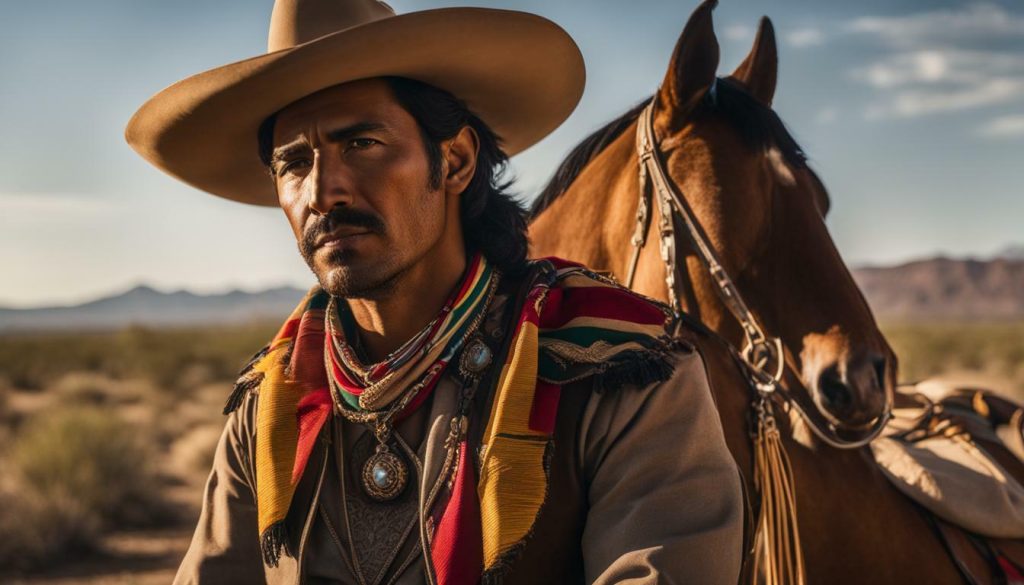
The Mexican cowboy’s charm and allure have transcended borders, captivating audiences and inspiring future generations. Their vaquero culture serves as a reminder of the rich history and traditions that continue to shape the cowboy way of life. As they carry forward the torch of the vaquero, Mexican cowboys will always be celebrated for their charisma, skills, and unwavering commitment to their heritage.
| Vaquero Skills | Traditional Mexican Wear | Rodeo Events |
|---|---|---|
|
|
|
The Future of the Mexican Cowboy
As we look to the future, it is essential to preserve the vaquero culture and honor the legacy of the Mexican cowboy for generations to come. The vaquero, also known as the Mexican cowboy, has a rich history that originated in the Iberian Peninsula and developed extensively in Mexico. These skilled horse-mounted livestock herders played a crucial role in the ranching industry, herding cattle and training newcomers in cowboy skills.
The vaquero culture still thrives today in modern-day rodeo events and on ranches across the United States. Many vaquero techniques, such as horsemanship and cattle herding, are still employed by ranchers who value the traditions passed down through generations. The vibrant culture and traditional attire of the Mexican cowboy continue to captivate audiences worldwide, showcasing the enduring charisma of this iconic persona.
Efforts are being made to preserve the vaquero culture and ensure its continuation in the face of modern challenges. Mexican ranchers and ranching families play a vital role as guardians of tradition, passing down their knowledge and skills to future generations. By embracing the vaquero culture and celebrating the Mexican cowboy, we can ensure that their legacy lives on, connecting us to our rich cowboy heritage.
As we move forward, it is crucial to recognize the significance of the vaquero culture and its contribution to the broader cowboy narrative. By honoring the Mexican cowboy and preserving the vaquero traditions, we pay tribute to a legacy that has shaped our history and continues to inspire us today.

